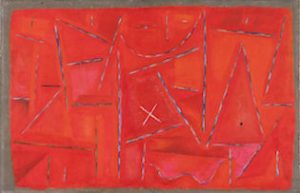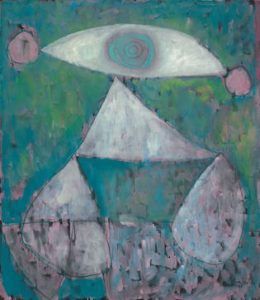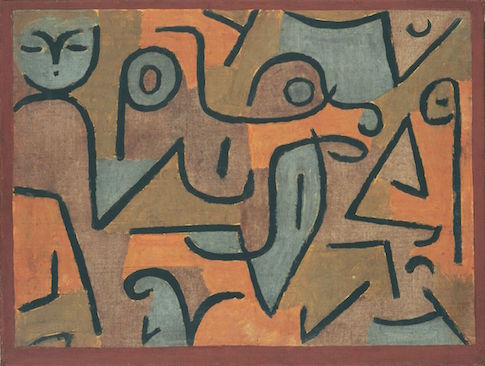On a television show I was watching the other night, a teacher described a puzzling conversation she had with her student. "He asked me if I saw the color blue the same way he did," she said. When asked what her answer was, she wistfully replied, "I said the truth. I don't know." It was a pretty bizarre comment: Except for the colorblind, humans all see color virtually the same way—a pigment absorbs all the color it is not, and reflects the color that we see. What we take from a work of art, however, where colors are moved around to make an entire painting, is far more complex. What is it in an artist's technique that makes him great?
The greatness of an artist is not only shown in the body of his work, but in the volume of artists he clearly influenced. Such is the case of Paul Klee, whose work can be seen alongside American artists who followed his technique at the Phillips Collection in its latest exhibit "Ten Americans: After Paul Klee." It is the only stop of the show in the United States, born from a commendable collaboration between the Phillips's Elsa Smithgall and the Zentrum Paul Klee's Fabienne Eggelhöfer of Switzerland.
Paul Klee struggled with the choice of being a musician or a painter before resting on the latter. He was born in Switzerland in 1879, but his life as an artist flourished when he moved to Germany in 1906, where he taught at the Bauhaus until 1931, and then was a professor at the Düsseldorf Academy of Art. When the Nazis came to power, Klee's tenure was suspended, and he and his wife returned to Switzerland. But it was in the United States where his art caught on, although he never ventured here before his death in 1940. Between 1938 and 1960, at least one solo show of Klee's work was exhibited in New York each year.
Young American artists loved Klee for his whimsical abstraction. His lines dance across a field of color like Keith Haring figures; they range from calligraphic and fuzzy to slim and detailed. These strange symbols could be seen as pointless, requiring only juvenile skill. But Klee’s message was simple and primordial. He wanted to convey the subconscious, and the final product showed where spontaneity met control.
Each of the Americans whose works hang in the Phillips saw the same Klee works, but received different influences. Adolph Gottlieb is the most notable, whose painting The Sounds at Night directly echoes the mysterious symbols in Klee's Young Moe. Gottlieb's swirling white symbols rest on gray hues that melt into ochre browns, a soft palette that still manages to send tremors to the eye. His works hang alongside Bradley Walker Tomlin's, who was also evidently enamored by Klee's symbols, which he worked into brusque, thick lines that dash across huge canvasses. Klee considered drawing symbols synonymous to writing, insisting, "Since the dawn of civilization, drawing and writing … were the same thing."
The Phillips notes that while the 10 featured artists did not necessarily copy Klee's work, they each were inspired by his technique. Mark Tobey's intricate lines over a mysterious wash of subdued color reflect Klee's watercolors, which he would scratch over with various shapes, giving the effect of a primitive landscape. Norman Lewis did the same, and his quirky scribbles when approached closely will reveal details from etched faces to a small abyss. These techniques, according to the Phillips, were inspired by Klee's musical understanding that inspirited rhythmic, waving lines resting on a bed of foggy color.

Gene Davis's and Kenneth Noland's works express that fantastic use of color, although Noland sometimes ignored Klee's simplicity. His painting's fat layers are slashed by striking primary shades of blue or red, but their abstract nature owes much to Klee's thinking. Noland discovered Klee while he was studying under Klee's friend Josef Albers at Black Mountain College, where he became obsessed with abstraction. His overwhelmingly red In the Garden deftly leads its viewers into a playground, where the shapes of swing sets are reduced to their simple, triangular forms. Klee was indeed an abstractionist in both thought and action, saying, "Art does not reproduce the visible but makes visible."
That line of thinking is what led Klee's followers William Baziotes and Theodoros Stamos to integrate primordial, amoeba-like shapes into their work. The two used painting as a method to confront their connection to the natural world. Baziotes's paintings reflect an enticing marine universe, swirling with frothy greens, yellows, and blues dappled by velvety lavender. Stamos also invites the viewer to perceive nature through his eyes, in a painting of a full moon or of amorphous splotches one would recognize as cells under a microscope. They appear inspired by Klee's Tropical Blossom, a landscape made of a single flower. A magenta, door-like figure is seen at the bottom, enticing viewers into a tiny, chimerical world.
"To be natural is to be obvious," Oscar Wilde wrote, "and to be obvious is to be inartistic." Bad art comes from transparent, unfiltered intent, and while some may think that some of Klee's works are composed of uncensored doodles, they couldn't be more wrong. Rather, he would begin his paintings with rune-like shapes before approaching the painting again to imprint more conscious decisions. That first step, as with arguably anything, was rooted in the subconscious, but his second was what made him an artist.
The Phillips shows how Jackson Pollack and Robert Motherwell used that technique of conscious spontaneity.

Before he encountered Klee, Pollack expressed to his brother that he found his own drawings "rotten," lacking freedom and rhythm. Although most art-lovers would associate Pollack with splatter, his ink drawings show his discipline. Even in his paintings, there is a method of control, in which he would approach the painting repeatedly to layer more paint to create a technically arresting composition. Motherwell attempted the same, although his layers fall flat. It is evident that these artists were not creating a painting out of solipsistic needs. They were working to make something that would please the eye, even if unexpectedly.
These 10 artists all absorbed the lessons of Klee's work, but more important they resonated with the philosophy behind it. Their following his path was not as simple as seeing pigment, or regarding a shape. Klee's work is far greater than that.
